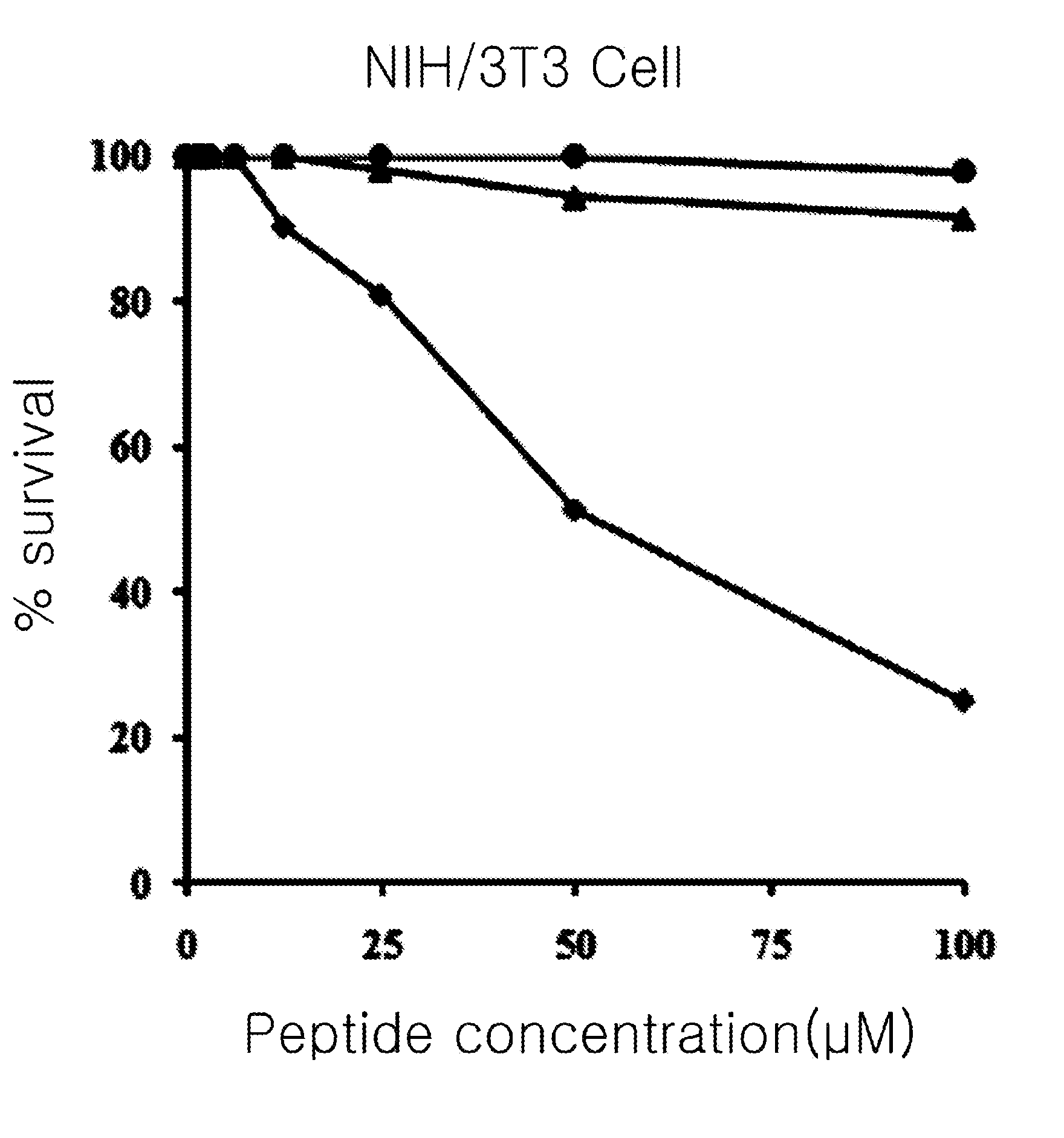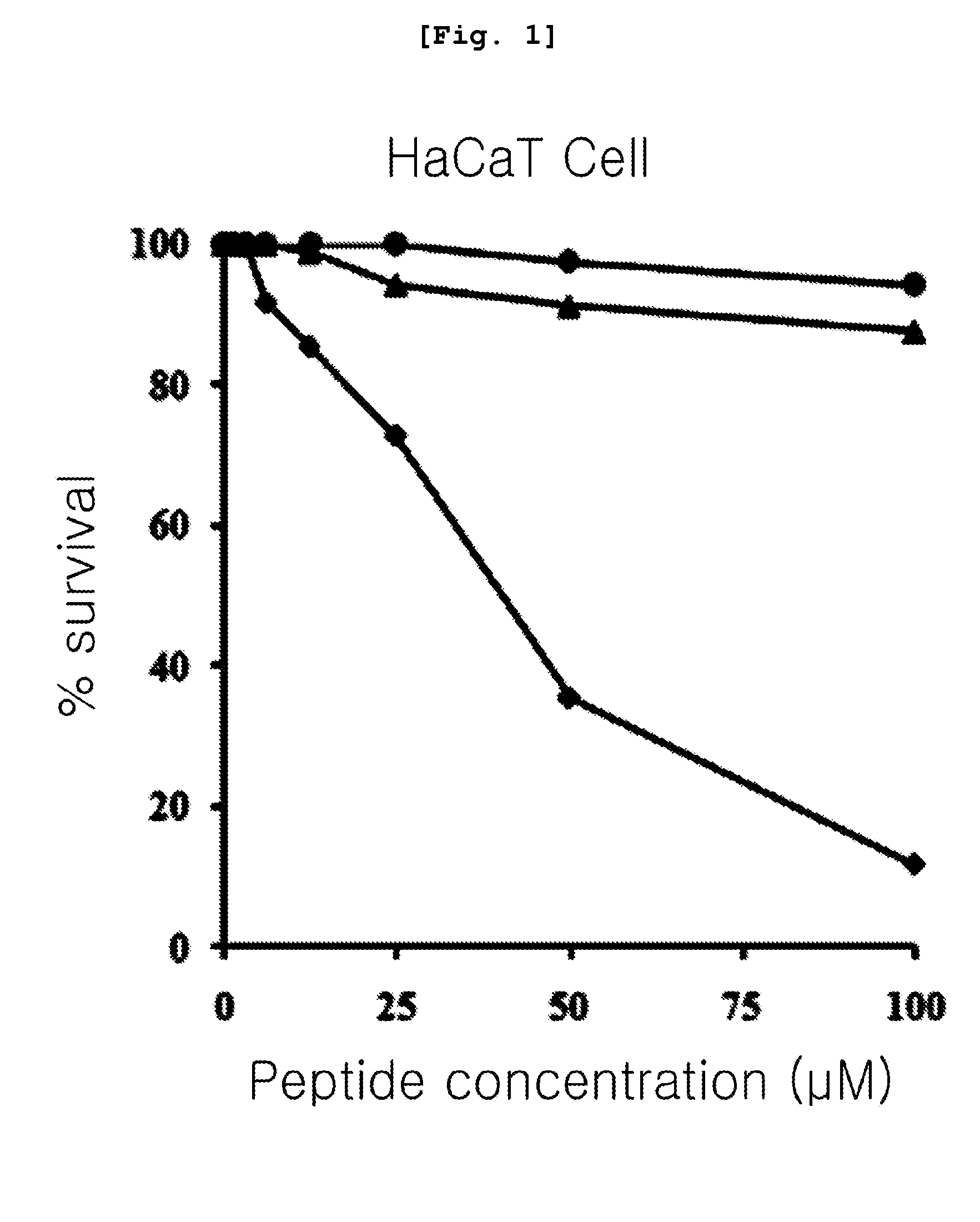Novel antibiotic peptide derived from ribosomal protein l1 of helicobacter pylori and use thereof
a technology of helicobacter pylori and ribosomal protein, which is applied in the direction of peptide/protein ingredients, antibacterial agents, peptide sources, etc., to achieve the effect of more radical antimicrobial activity
- Summary
- Abstract
- Description
- Claims
- Application Information
AI Technical Summary
Benefits of technology
Problems solved by technology
Method used
Image
Examples
experimental example 1
Synthesis and Isolate Refinement of the Antibiotic Peptides
[0081]The present inventors, according to the liquid-solid method (Merrifield, R B., J. Am. Chem. Soc., 85, 2149, 1963), substituted two phenylalanines, which is situated at the first and the eighth position in HPA3NT3 (control group) comprising the amino acid sequence of SEQ. ID. NO:1, maternal peptide, with alanine not including phenyl group, and synthesized NT3-F1AF8A peptide (Sequence no. 2)(experimental group 1), wherein in order to increase positive ion charge from the NT3-F1AF8A peptide they substituted asparagin, which is situated at thirteenth position in HPA3NT3 and negative charge amino acid, with lysine, which is positive charge amino acid, and synthesized NT3-F1AF8A-A2 peptide (Sequence no. 3) (experimental group 2) (Table 1).
[0082]Specifically, a peptide having —NH2 form at the carboxyl terminal prepared by the present invention used Rink Amide MBHA-Resin as a stating substance and a peptide having —OH form at ...
experimental example 2
Measurement of Antimicrobial Activity
[0083]The present inventors measured MIC, which is the minimum concentration of not divided bacterial cell, in order to compare the antimicrobial activity of the peptide prepared by the method of .
[0084]More specifically, the present inventors used Escherichia coli, Pseudomonas aeruginosa, Proteus vulgaris, Salmonella typhimurium as a Gram negative bacterium and used Staphylococcus aureus, Listeria monocytogenes, Staphylococcus epidermidis, Bacillus subtilis as a Gram positive bacterium. In addition, Escherichia coli (ATCC 25922), Listeria monocytogenes (ATCC 19115), and Staphylococcus aureus (ATCC 25923) were provided by “American Type Culture Collection” and Bacillus subtilis (KCTC 1918), Streptococcus epidermidis (KCTC 3096), Pseudomonas aeruginosa (KCTC 1637) and Proteus vulgaris (KCTC 2433) were provided by “Korean Collection for Type Cultures”. After culturing each strain by up to mid-log phase in LB medium (1% Bacto tryptone, 0.5% extracti...
experimental example 3
Measurement of Hemolytic Activity
[0087]The present inventors measured erythrocyte hemolytic activity of the peptides in order to compare the cytotoxicity of the peptides prepared by the method of the .
[0088]Firstly, the present inventors diluted human erythrocyte with phosphate buffer (PBS, pH 7.0) to be a 8% concentration and then, they diluted each described peptide comprising the amino acid sequence of SEQ. ID. NO: 1 to 3 in the Table 1 continually at the ½ concentration starting from 200 μM and make them reacted for 1 hour at 37° C. After then, the present inventors measured the amount of hemoglobin included in the supernatant obtained by centrifugating it with 1,000 g and the absorbance under the 414 nm of wavelength of the supernatant. In order to investigate relative level a comparative study of cytotoxicity, they measured the absorbance of supernatant with adding 1% triton X-100 (sigma, USA) to the human erythrocyte cell. Making the cytotoxicity of 1% triton X-100 to become ...
PUM
| Property | Measurement | Unit |
|---|---|---|
| positive charge | aaaaa | aaaaa |
| resistance | aaaaa | aaaaa |
| concentration | aaaaa | aaaaa |
Abstract
Description
Claims
Application Information
 Login to View More
Login to View More - R&D
- Intellectual Property
- Life Sciences
- Materials
- Tech Scout
- Unparalleled Data Quality
- Higher Quality Content
- 60% Fewer Hallucinations
Browse by: Latest US Patents, China's latest patents, Technical Efficacy Thesaurus, Application Domain, Technology Topic, Popular Technical Reports.
© 2025 PatSnap. All rights reserved.Legal|Privacy policy|Modern Slavery Act Transparency Statement|Sitemap|About US| Contact US: help@patsnap.com



